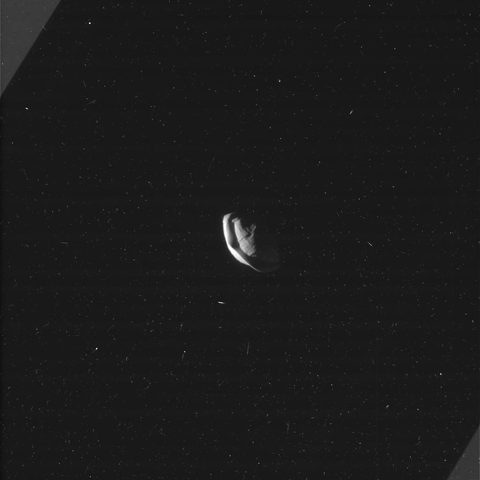Besides Earth, Saturn may be the only other planet where you can order rings with a side of ravioli. Closeup photos taken by the Cassini probe of the the planet’s second-innermost moon, Pan, on March 7 reveal remarkable new details that have us grasping at food analogies in a feeble attempt to describe its unique appearance.
How long is a day on Mercury
Mercury is one of the most unusual planets in our Solar System, at least by the standards of us privileged Earthlings. Despite being the closest planet to our Sun, it is not the hottest (that honor goes to Venus). And because of its virtually non-existence atmosphere and slow rotation, temperatures on its surface range from being extremely hot to extremely cold.
Comets or volcanoes? Scientists are changing their minds about how the Earth’s water got here
The Earth has been the blue planet for as many as 3.8 billion years. Ancient sedimentary rock deposits and lava that cooled into characteristic pillow shapes provide irrefutable evidence that liquid water has existed at the Earth’s surface for at least this long. But given how many barren rocks there are in the galaxy, Earth’s abundant oceans raise the question of where all that water came from.
Conservation efforts must include small animals. After all, they run the world
When galaxies collide, stars suffer the consequences
When galaxies collide, the result is nothing short of spectacular. While this type of event only takes place once every few billion years (and takes millions of years to complete), it is actually pretty common from a cosmological perspective. And interestingly enough, one of the most impressive consequences – stars being ripped apart by supermassive black holes (SMBHs) – is quite common as well.
Health Check: are naps good for us?
Catnap, kip, snooze, siesta; whatever you call naps, there is no doubt these once frowned-upon short sleeps are gaining acceptance. The increase in popularity is not surprising, with the Centers for Disease Control and Prevention in the US finding around a third of American adults do not get the recommended seven hours sleep each night.
A Galaxy on the Edge
This colourful stripe of stars, gas, and dust is actually a spiral galaxy named NGC 1055. Captured here by ESO’s Very Large Telescope (VLT), this big galaxy is thought to be up to 15 percent larger in diameter than the Milky Way. NGC 1055 appears to lack the whirling arms characteristic of a spiral, as it is seen edge-on. However, it displays odd twists in its structure that were probably caused by an interaction with a large neighbouring galaxy.
How far is Mercury from the sun?
Mercury is famously known for being a scorching hot world. On the side that is facing towards the Sun, conditions can get pretty molten, reaching temperatures of up to 700 K (427 °C; 800°F) in the equatorial region. The surface is also airless, in part because any atmosphere it could generate would be blown away by solar wind. Hardly surprising, considering it is the closest planet to our Sun.
The evidence that shows dinosaurs were in decline for 40 million years before the asteroid hit
When the dinosaurs were wiped off the face of the planet, how did they leave? Was it a slow, plodding decline or a short sharp bang? Back in the 1960s and 1970s, debate about this question was mainly taking place on the ground, at fossil sites in places like Montana. Paleontologist Robert Sloan and his colleagues documented evidence for the long-term decline of dinosaurs over a 10m to 20m-year period. Dinosaurs had been losing out, ever so slowly, to the rising mammals, mainly as a result of cooling climates.
How we can use light to fight bacteria
During the early part of the last century, dyes were frequently used to disinfect wounds. During the first world war, thousands of lives were saved by “flavine therapy” which used dyes such as Brilliant Green and Acriflavine. The dyes were applied to bullet or shrapnel wounds to kill the bacteria at the site of the injury – for example, bacteria which causes gas gangrene. But now these dyes are being resurrected to treat bacterial infections, but with a new twist: light.
How science can make your baby sleep better
Explainer: why do we get butterflies in our stomachs?
The search for extraterrestrial life in the water worlds close to home
The discovery of seven exoplanets around a star 40 light years from our Sun has raised the possibility that they could harbour life. Why? Because the astronomers who made the discovery believe some of the planets may have liquid water. And on Earth, wherever there is liquid water, there is life. But we believe we can look much closer to Earth
Chronic stress could be making you fat
Rising life expectancy and why we need to rethink the meaning of old age
You are living inside a massive, musical instrument – and here’s what it sounds like
The ancients believed that the Earth was surrounded by celestial spheres, which produced divine music when they moved. We lived, so to speak, in a huge musical instrument. This may sound silly but modern science has proved them right to a certain extent. Satellites recording sound waves resonating with the Earth’s magnetosphere – the magnetic bubble that protects us from space radiation – show that we are indeed living inside a massive, magnetic musical instrument.
Fact or fiction – is sugar addictive?
Sad about Pluto? How about 110 planets in the solar system instead?
In 2006, during their 26th General Assembly, the International Astronomical Union (IAU) adopted a formal definition of the term “planet”. This was done in the hopes of dispelling ambiguity over which bodies should be designated as “planets”, an issue that had plagued astronomers ever since they discovered objects beyond the orbit of Neptune that were comparable in size to Pluto.
Five of the most explosive non-nuclear chemicals ever made
Explainer: what is wave-particle duality
Our notion of reality is built on everyday experiences. But wave-particle duality is so strange that we are forced to re-examine our common conceptions. Wave-particle duality refers to the fundamental property of matter where, at one moment it appears like a wave, and yet at another moment it acts like a particle. To understand wave-particle duality it’s worth looking at differences between particles and waves.









